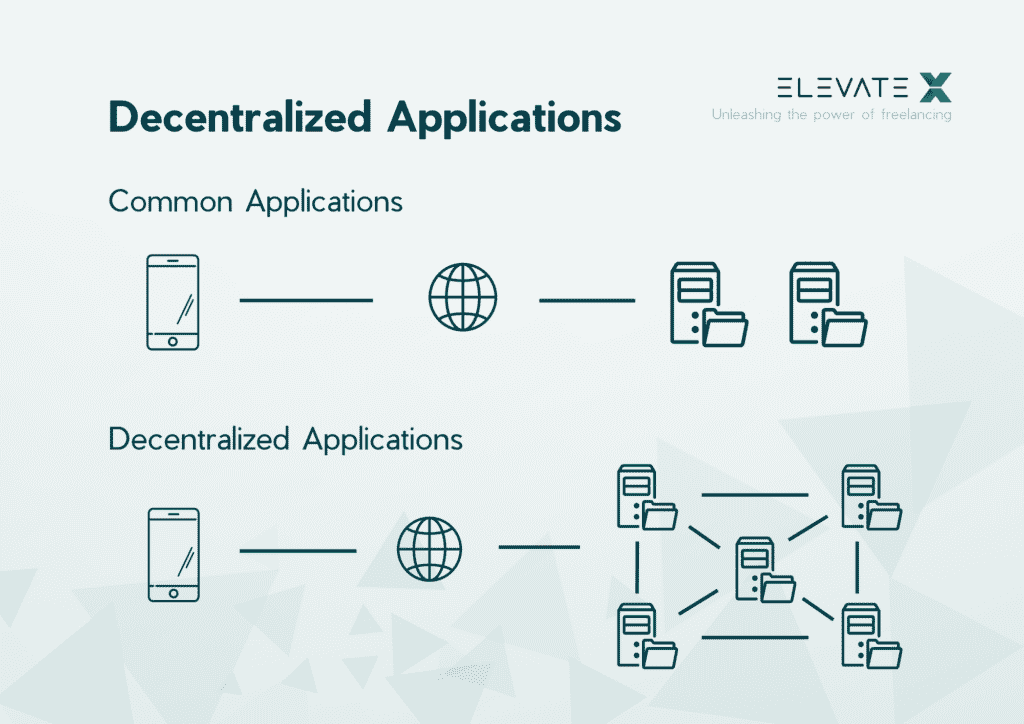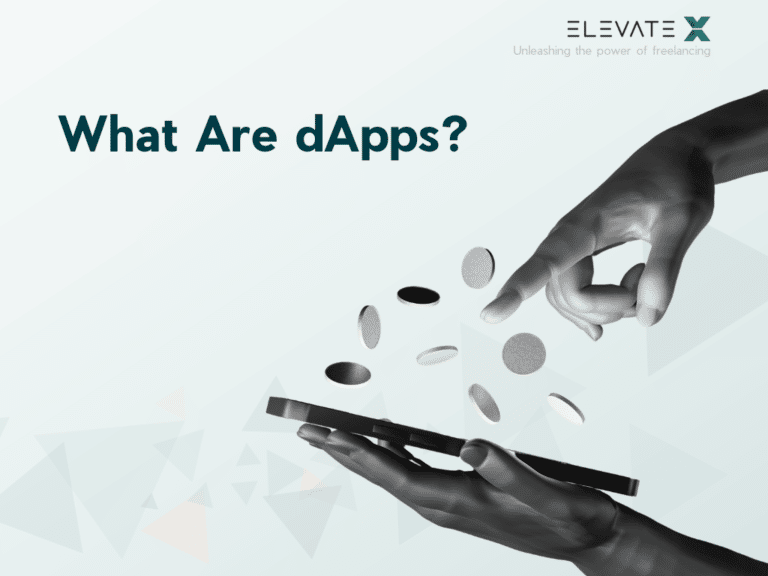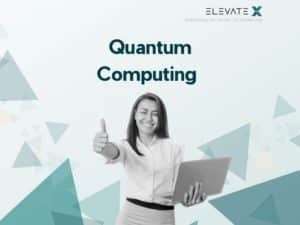In previous posts, we have already covered a lot about blockchain technology, its use cases and potential applications. We have also summarized all the topics and sub-topics relating to Web3 in our detailed Web3 Roadmap. Another use case for blockchain is so-called dApps, or decentralized apps. There are now over 4,000 such applications with almost 115,000 users every day. The trend is still rising.
But what exactly are dApps? Where is the difference to traditional applications? And what already exists for dApps?
What Are dApps?
The main difference of decentralized apps lies in the backend, which is why hardly anything changes in the user interface itself. DApps are based on so-called smart contracts. The special feature of smart contracts is automation. As soon as a contracting party has fulfilled its obligations, a payout can be made automatically and autonomously. Smart contracts also work according to the rules of the blockchain.
A key feature of the blockchain is that once information is attached, it cannot be changed, which is what makes it so secure. Thus, this also applies to decentralized applications.
As the name suggests, dApps are decentralized. With conventional applications, the information is stored on central servers of the respective provider, over which the provider also has control. This is not the case with dApps. With blockchain networks, a copy of the data is stored on every device that is part of a blockchain network. Thus, no individual or company controls the application.
In this regard, most applications are based on the open-source blockchain system, Ethereum.

dApps Are Based on Four Criteria
OpenSource
The source code for the application must be freely available for everyone to see. In addition, there is no central authority that decides on the course of the source code. Thus, the source code operates autonomously.
Blockchain
As mentioned at the beginning, decentralized applications are based on blockchain technology and therefore also adopt its characteristics.
Encrypted Tokens
Tokens can be understood as digital units that represent a copy of a sensitive record on a blockchain. In many cases, these are the currency of a particular blockchain. For example, Bitcoin is the currency of the Bitcoin blockchain.
Generation of Tokens
DApps must provide a mechanism to provide encrypted tokens. Bitcoin, for example, uses the proof-of-work algorithm. Miners can provide computing power to generate bitcoins.
As an alternative to proof-of-work, there is the proof-of-stake. In this article, we explain the differences and what consensus mechanisms are exactly.
The Different Types of dApps
Type 1
The first type is an application with its own blockchain. This is the case with Ethereum or Bitcoin, for example.
Type 2
The second type is an application based on a different blockchain. An example of this is GNOSIS, an application for decentralized prediction markets. GNOSIS is based on Ethereum and thus belongs to type 2.
Type 3
Applications of this type are based on a type 2 protocol. An example of this is the SAFE network, which is based on the Omni protocol, which in turn is built on the Bitcoin blockchain.
An example for illustration. Type 1 can be understood as an operating system, i.e. Windows, MacOS or Linux. Type 2 would then be an application that runs on the respective operating system, such as Photoshop, Microsoft Word or similar. Type 3 would be a kind of plug-in that runs within this application. For example, a grammar tool for Word or an extension for Photoshop.
How Can I Use dApps?
First of all, you need to set up a cryptocurrency wallet. MetaMask is one of the best known and can be used within most browsers. In simple terms, you can think of it as Apple Pay for cryptocurrencies. One can store tokens, send or receive them. Mainly for the currency of the blockchain system Ethereum, Ether.
After depositing Ether, you can use your balance to pay for online services and access various dApps.
What dApps Are Already Available?
Ethereum has divided a list of decentralized apps into four different categories on its website. In addition, however, it must be noted that many of these apps are still experimental and only show the possibilities of decentralized networks.
Finances
This category includes apps that specialize in cryptocurrency trading and thus act as a kind of bank. One can borrow, lend, and make private payments.
Investments, trading, crowdfunding and insurance are also possible.
Examples:
Aave
Uniswap
Nexus Mutual
Gitcoin Grants
Art and Collectibles
In principle, digital property can be acquired with these apps. NFTs also play an important role in this.
NFT stands for “non-fungible token. Unlike the conventional tokens explained earlier, these are therefore not exchangeable. An NFT is thus unique and can be ideally used for digital assets, of which there are only a few.
Examples:
Foundation
POAP
Audius
Gaming
In the gaming category, applications focus on creating virtual worlds or competing with other players to generate things that have real-world value.
Examples:
Cryptovoxels
Gods Unchained
Technology
Applications in this category focus on advancing decentralized technology: working on open-source software, gaining access to computing power, or secure peer-to-peer collaboration without intermediaries.
Examples:
Ethereum Name Service
Gitcoin
Golem
Brave
In any case, it is necessary to invest a certain amount of Ether beforehand in order to access the applications. Ethereum clearly points out that you should familiarize yourself intensively with the topic before investing larger amounts, as this is always associated with a certain risk.
What Are Advantages?
Since decentralized applications are based on the blockchain, the advantages and disadvantages coincide.
You can read about them in detail in our Beginner’s Guide to Blockchain.
Here is the summary:
Security and Data Protection
Once attached, data records cannot be changed, making the applications extremely secure, especially in financial services.
Trust
In most areas where trading takes place, an intermediary is required, i.e., a bank or a seller. With dApps, these are not needed and contracts or payments are made via smart contracts.
Protection Against Technical Issues
Since data is no longer stored on a central server but on the end devices of all participants in a blockchain, they are protected against loss. If one device fails, the other participants maintain the network.
User Empowerment
Since the source code is publicly visible, users have a better overview of all existing data. This also makes censorship and non-transparent handling of sensitive data much more difficult.
What Are Disadvantages?
Complexity
The topic around blockchain is extremely complex and still a very unexplored area in IT. For this reason, as already mentioned, it is very important that one deals intensively with the topic before starting to invest larger amounts in NFTs or similar.
High Energy Consumption
Transactions and also mining of cryptocurrency requires a lot of computing power and therefore also a lot of energy.
Private Keys
Each part of the blockchain has its own private key, which protects the data well and securely from attacks. However, if this key is lost, there is no way to access the data. In many cases, a large amount of money has already been lost.
dApps FAQ
As the name suggests, dApps are decentralized. With conventional applications, the information is stored on central servers of the respective provider, over which the provider also has control. This is not the case with dApps.
dApps have an open-source source code that is publicly available for everyone to see. Furthermore, dApps are based on blockchain technology and therefore also adopt its properties. Additionally, they have tokens, a kind of digital unit of the respective blockchain. The fourth and final criterion is that each central application must generate these tokens so that users can earn them.
On the Ethereum website you can find a list of different decentralized apps. These apps are mostly programmed by third parties and are still experimental. They are basically supposed to have the possibilities of decentralized apps.








